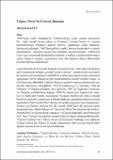- DSpace Home
- →
- Kurumsal Yayınlardaki Makaleler
- →
- İletişim Çalışmaları Dergisi
- →
- View Item
JavaScript is disabled for your browser. Some features of this site may not work without it.
| dc.contributor.author | Kazan, Hüseyin
|
|
| dc.date.accessioned | 2020-01-03T07:18:20Z | |
| dc.date.available | 2020-01-03T07:18:20Z | |
| dc.date.issued | 2017-10 | |
| dc.identifier.uri | http://hdl.handle.net/11547/5247 | |
| dc.description.abstract | 1960’larda Latin Amerika’da Hollywood’un ticari sinema anlayışına bir tepki olarak ortaya çıkan ve Ukamau, Cinema Novo vb. sinema hareketlerinden beslenen üçüncü sinema, günümüze kadar halkasını büyüterek gelmiştir. 1960’ların politik içerikli sinema hareketleri ve teorik manifestoları “üçüncü sinema”nın temelini oluşturmaktadır. 1960’ların siyasi kaos ortamında düşük bütçeli filmler ve radikal manifestolarla ortaya çıkan “üçüncü sinema”, gelişmekte olan tüm üçüncü dünya ülkelerinde karşılık bulmaya başlamıştır. Latin Amerika’da Fernando Solanas, Octavio Getino, Julio Garcia Espinosa gibi yönetmenlerin başını çektiği “üçüncü sinema”, içinde politik sinemanın da unsurlarını barındırarak muhalif bir sinema anlayışının ortaya çıkmasını sağlamıştır. 60’lı yıllarda devrim hareketlerinin önemli isimleri Fanon ve Che Guevara, dikkatleri Üçüncü Dünyaya çekmek isteyen sinemacılar için önemli referanslar olmuşlardır. 1945’te Endonezya ve Vietnam, 1946’da Filipinler’in bağımsızlıklarını ilan etmeleri; 1947’de bağımsız Hindistan ve Pakistan devletlerinin doğuşu, 1948’de Burma’nın bağımsızlık ilanı; Çin ve Küba devrimleri, başlangıçta ‘Üçüncü Sinema’nın ürün vereceği belirli bir atmosfer yaratmıştır. Giderek halkasını genişleten üçüncü sinema hareketleri 1960’larla birlikte Türkiye’de de etkisini göstermeye başlamıştır. Türkiye’de Üçüncü Sinema’nın ilk temsili 1960’ların ilk aylarına kadar dayanmaktadır. Metin Erksan’ın “Gecelerin Ötesi” bu anlamda ilk olurken, Ertem Göreç’in “Karanlıkta Uyananlar” ve Duygu Sağıroğlu’nun “Bitmeyen Yol” filmi Türkiye’nin üçüncü sinema filmleri olarak nitelendirilmektedir. “Üçüncü Sinema”nın Türkiye’de en iyi karşılığını bulduğu isim şüphesiz Yılmaz Güney’dir. Güney’in kendi yaşamından izler taşıyan birçok filmi üçüncü sinema kriterlerini karşılamaktadır. | tr_TR |
| dc.language.iso | tr | tr_TR |
| dc.publisher | İstanbul Aydın Üniversitesi İletişim Çalışmaları Dergisi | tr_TR |
| dc.subject | Üçüncü Sinema | tr_TR |
| dc.subject | Fernando Solanas | tr_TR |
| dc.subject | Octavio Getino | tr_TR |
| dc.subject | Julio Garcia Espinosa | tr_TR |
| dc.subject | La Hora de Los Hornos | tr_TR |
| dc.subject | Yılmaz Güney | tr_TR |
| dc.subject | Metin Erksan | tr_TR |
| dc.subject | Yol | tr_TR |
| dc.subject | Duvar | tr_TR |
| dc.subject | Third Cinema | tr_TR |
| dc.subject | Fernando Solanas | tr_TR |
| dc.subject | Octavio Getino | tr_TR |
| dc.subject | Julio Garcia Espinosa | tr_TR |
| dc.subject | La Hora de Los Hornos | tr_TR |
| dc.subject | Yılmaz Güney | tr_TR |
| dc.subject | Metin Erksan | tr_TR |
| dc.subject | Way | tr_TR |
| dc.subject | Wall | tr_TR |
| dc.title | Yılmaz Güney’in Üçüncü Sineması | tr_TR |
| dc.type | Article | tr_TR |
| dc.description.abstractol | Third Cinema has emerged as a reaction to Hollywood’s commercial cinema in the 1960s and was fueled by the alternative movements in the cinema such as Ukamau, Cinema Novo and so on. The genre has reached our day by growing its ring of influence ever since. Cinema movements with political themes and theoretical manifestos of the 1960s constitute the foundation of the Third Cinema. Appearing in the form of low-budget films and radical manifestos of the chaotic political era of the 1960s, Third Cinema began to be reciprocated in all the developing, third world countries. Led by directors such as Fernando Solanas, Octavio Getino and Julio Garcia Espinosa in Latin America, Third Cinema led to the emergence of an oppositional cinema movement as it also nestled the elements of the political cinema. For the filmmakers who have wanted to draw attention to the Third World, the two important figures of the revolutionary movement in the 1960s, Che Guevara and Fanon have been quintessential references. The early political developments, such as the declaration of independence by Indonesia and Vietnam in 1945 and by Philippines in 1946, the birth of independent states of India and Pakistan, the declaration of independence by Burma in 1948, and last but not least the Chinese and Cuban revolutions created a specific atmosphere for Third Cinema to bear its fruits. Gradually increasing its ring of influence, the Third Cinema movements began its influence in Turkey by the 1960s. The first representation of the Third Cinema in Turkey dates back to the first months of the 1960s. Ertem Göreç’s Karanlıkta Uyananlar (Those Awakening in the Dark) and Duygu Sağıroğlu’s Bitmeyen Yol (The Never Ending Road) can be described as the early examples of Third Cinema in Turkey. Needless to say, Yılmaz Güney’s cinema is where the Third Cinema was most echoed. Many films by Yılmaz Güney, which also bear traces of his life experiences, meet the criteria of the Third Cinema. | tr_TR |
| dc.publisher.firstpagenumber | 41 | tr_TR |
| dc.publisher.lastpagenumber | 59 | tr_TR |
| dc.identifier.bibliographictag | Kazan, Hüseyin, Yılmaz Güney’in Üçüncü Sineması(2017), İstanbul Aydın Üniversitesi İletişim Çalışmaları Dergisi | tr_TR |
